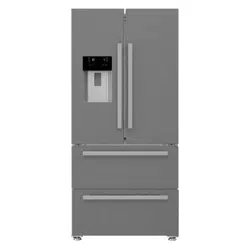Loading ...
Loading ...
Loading ...

29 / 38 EN
Refrigerator / User Manual
6 Care and Cleaning
Sponges and other types of cleaning cloths
may scratch the surface.
6.1. Avoiding Bad Odours
Materials that may cause odour are not used in
the production of our refrigerators. However, odour
may be emitted if foods are stored improperly or
if the inner surface of the product is not cleaned
as required. Please consider the following to avoid
this problem:
• It is important that the refrigerator is kept
clean. Food residuals, stains, etc. can cause
odour. For this reason, clean your refrigerator
with carbonate solved in water every 15 days.
Never use detergents or soap.
• Keep your foods in closed vessels.
Microorganisms emitted from vessels without a
cover may cause unpleasant odours.
• Never keep expired or spoiled foods in your
refrigerator.
6.2. Protection of
plastic surfaces
Do not put liquid oils or oil-cooked meals in your
refrigerator in unsealed containers as they damage
the plastic surfaces of your refrigerator. If oil is
spilled or smeared onto the plastic surfaces, clean
and rinse the relevant part of the surface with
warm water immediately.
6.3. Cleaning the Inner Surface
To clean the inner surfaces and all removable
parts, wash them with a mild solution comprising
soap, water and carbonate. Rinse and dry
thoroughly. Prevent the water from contacting the
lighting means and control panel.
A
ATTENTION:
Do not use vinegar, rubbing
alcohol or other alcohol-based
cleaning agents on any of the
inner surfaces.
6.4. Stainless Steel
Outer Surfaces
Use a stainless steel cleaning agent that is non-
abrasive and apply it with a lint-free, soft cloth.
For polishing, wipe the surface softly with a damp
microfiber cloth and use dry wash-leather. Always
follow the strands of the stainless steel.
6.5. Cleaning Products
with Glass Doors
Remove the protection foil on the glass.
There is a coating on the surface of the glass.
This coating minimises stain formation and
ensures that stains and dirt are cleaned
easily. Glasses that are not protected by a coating
might be exposed to permanent bonding of organic
or inorganic, air or waterborne pollutants such as
limescale, mineral salts, unburned hydrocarbons,
metal oxides an silicons, which lead to stains and
physical damage in a short time. Despite regular
washing, the glass becomes very hard to keep
clean, though not impossible. As a result, the
clarity and good appearance of the glass reduces.
Hard and abrasive cleaning compounds and
methods increase these defects even further and
accelerate the deterioration process.
*Non-alkali, non-abrasive and water-based
cleaning products must be used for routing
cleaning procedures.
For the coating to have long service life, alkali
or abrasive substances must not be used during
cleaning processes.
These glasses were subject to a tempering
process to increase their impact and breakage
resistance.
As an additional safety measure, there is a safety
film on the back surfaces of the glasses to ensure
that they will not harm the environment in case of
breakage.
Loading ...
Loading ...
Loading ...
